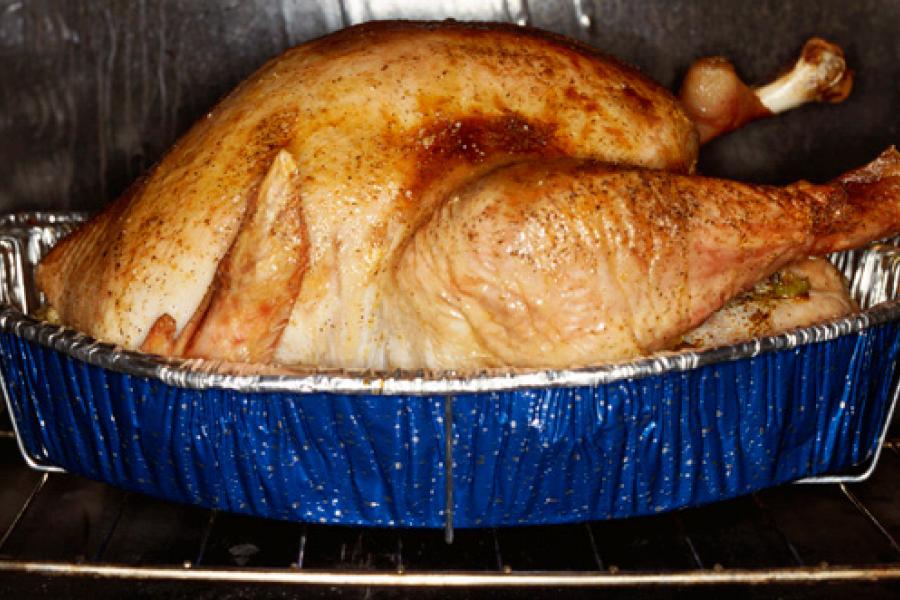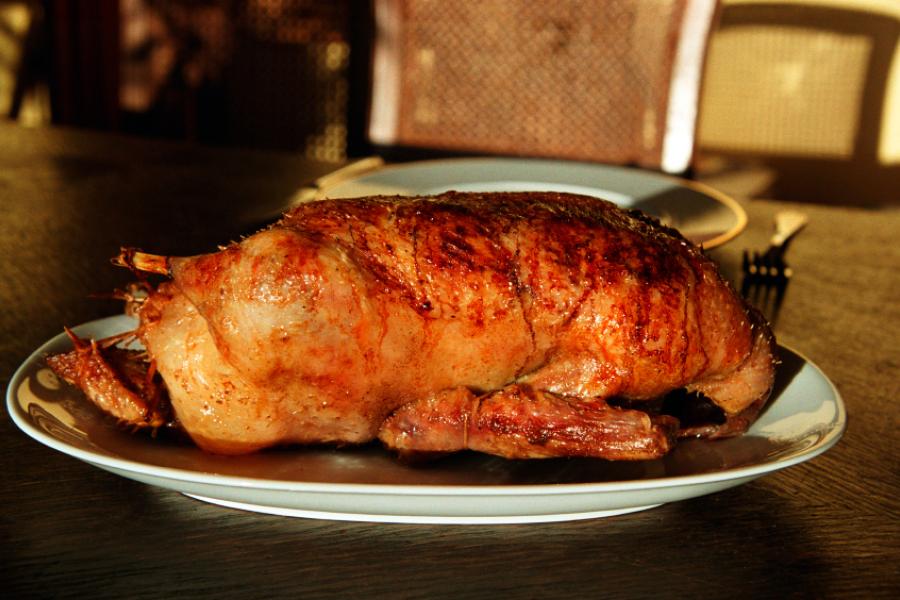Roasting poultry
Roasting is the most popular method to cook poultry, let it be chicken, turkey, duck or goose.
Roasting is the most popular method to cook poultry, let it be chicken, turkey, duck or goose. Roasting poultry is similar to roasting meat, with a few particulars about how poultry is handled.
Temperatures and times
The temperature chosen will depend on the poultry meat being roasted.
Timing is essential when roasting poultry at high temperature, as just a few minutes over time will render an over-cooked and dry bird. Roasting at high temperature is used preferably for small birds.
Game birds or squab, often served rare, can be successfully roasted at high temperature.
A small chicken - under 3 lb - or Guinea hen can be roasted a t high temperature, cook at 450°F (230°C) for 45 minutes.
Because of its large fat content and medium to small size, duck can be roasted at continuous high temperature as long as it is well timed.
For large birds such as turkey, capon or goose, a low temperature roasting will result in tender, juicy meat.
Roast turkey with stuffing, duck or goose at 325°F (160ºC) allowing 25 minutes per pound (1 lb or 500g) plus 25 minutes.
Turkey may be roasted from 250ºF (120ºC) if it is not stuffed, but roasting times can become exceedingly long.
For chicken and other small to medium sized poultry, a fairly high temperature works best. A low temperature, the bird tends to stew in its own juices rather than roasting and they may not brown properly.
Roast chicken at 375ºF (180ºC) estimating 20 minutes per pound (1 lb or 500 g) plus 20 minutes.
A small to medium size chicken - up to 5 lb or 2 kg - or chicken parts can be seared at very high temperature and then finished at low temperature. Cook at 450ºF (230ºC) for 15 minutes and then continue at 325ºF (160ºC) until done.
Roasting times for chicken
| Size of Chicken | Fahrenheit | Celsius | Roasting Time |
|---|---|---|---|
| Poussin (up to 2 lb or 1 kg) |
400˚F | 200˚C | 25-40 minutes |
| Small chicken (less than 3 lb - or 1.4kg) |
400˚F | 200˚C | 15 minutes per 1 lb + 15 minutes |
| Medium size (3-5 lb or 1.4-2.3 kg) |
400˚F 375˚F |
200˚C 180˚C |
18 minutes per 1 lb + 18 minutes 20 minutes per 1 lb + 20 minutes |
| Large chicken (5 lb up to 10 lb or 2.3 kg up to 4.5 kg) |
375˚F | 180˚C | 25 minutes per 1 lb + 25 minutes |
Roasting methods
There are three simple methods: classic oven roasting, spit roasting and pot roasting.
- If present, remove giblets and reserve, clean and season inside.
- Truss the bird. Season the skin with salt and pepper if it is going to be served.
- Brush the skin with oil or butter.
Classic oven roasting
Pre-heat the oven, before preparing the bird. The breast can be covered with rashers of streaky bacon - barded - to prevent it from drying out -this is not necessary when roasting chicken breast down. For large birds, it may be necessary to cover breast and top of the thighs with foil at some point to prevent scorching. Remove during the last 30 minutes to allow browning and crisping.
If your oven size and bird size allow it, put the bird on a rack in a roasting pan.
- Place the bird breast down or on one side.
- Turn on the other side after a quarter of the cooking time.
- Finally, turn the bird on its back to let the breast brown. Baste with the fat in the roasting pan.
- Remove the bird from the roasting pan and keep warm until it is time to serve.
- Pour off fat and use the pan juices to make gravy.
Duck and goose benefit from adding some cider to the pan half way through the cooking time. White wine agrees very well with chicken.
Spit roasting
Same principles apply for poultry roasted in a turning spit than classic oven roasting, only remember that the smaller the bird, the closer it should be to the heat.
Make sure the bird is evenly balanced on the spit. The bird bastes in its own juices as it turns and it does need any extra fat but it can be brushed with butter or oil, and flavored with herbs and spices.
Pot roasting
The bird is cooked covered in a casserole pot, either in the oven. The chicken is usually cooked whole after browning in oil or butter. The pot should be large enough to contain the chicken and vegetables without crowding.
General
Poultry should always be well done - with the exception of squab and some game birds.
Season the inside of the bird. Only season the skin if it is going to be served and eaten as the seasoning does not penetrate it.
For chicken or turkey, brush the skin with oil or butter before cooking - butter will brown faster. For duck or goose, you may prick the skin to let their own fat get out while cooking.
Birds roasted breast down or in a spit do not need basting. Duck and goose have their own thick layer of fat and do not need basting.
Professional advice: basting only with fat and don't baste large birds only every 30 minutes or so, otherwise the heat loss is too large and leads to uneven cooking.
Quick guide for most common birds
Chicken - Cook at 375°F (180-190°C) for 20 minutes per pound + 20 minutes.
Capon - Cook at 375°F (180-190°C) for 20 minutes per pound + 20 minutes.
Turkey - Cook at 325°F (160°C) for 25 minutes per pound + 25 minutes. Cover the bird with foil or greaseproof paper to prevent burning and remove it at the end to brown the breast.
Goose - Cook at 400°F (200°C) for 15 minutes per pound + 15 minutes. It is recommended to cover the bird with foil or greaseproof paper to prevent burning. Only baste once and, should you wish, remove paper at the end to brown the bird.
Duck - Cook at 375°F (180-190190°C) for 30 minutes and reduce to 325°F (160°C) for the rest of the time. Cook for a total of 30 minutes per pound.
Roasting time may vary slightly if the bird is tightly trussed or considerably if the bird is stuffed.
Poultry in the world


